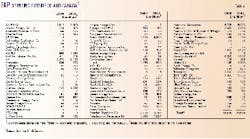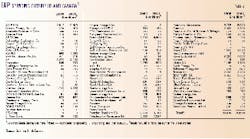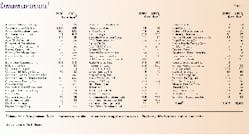Worldwide exploration and production outlays are expected to sustain near-record growth in 2001, according to Salomon Smith Barney, New York. This increase in E&P spending marks a period of transition for the oil services sector from a state of recovery to one of steady growth, the firm said.
In its 19th annual E&P spending survey, released late last year, Salomon said that it anticipates worldwide upstream spending in 2001 to increase by 19.7%-or by nearly $20 billion-compared with last year's estimates. This percentage increase is the largest seen in more than 2 decades, Salomon said.
The firm also noted that, this year, spending in the US and Canada vs. spending elsewhere in the world would come more closely into balance, with spending in the US and Canada expected to rise by a combined 19.1%-made up of a 19.3% increase in the US and an 18.8% jump in Canada-and spending outside these two countries to increase by 20.1%. This change comes following a year in which companies' E&P spending in the US and Canada was offset by a decrease in spending elsewhere, Salomon observed.
The 234 oil and gas companies surveyed by Salomon intend to spend $113.5 billion this year, up from an estimated $94.8 billion in 2000. Of the amount to be spent this year, 62% has been earmarked for outlays outside the US and Canada, while 11% will be spent in Canada, and 27% in the US.
Within the US, the 154 independent companies surveyed plan to spend $16.9 billion in 2001, up from the $14.1 billion spent the year before. The 11 major oil companies surveyed anticipate spending $12.8 billion this year, an increase from the estimated $10.9 billion in spending in 2000 (Table 1).
In the aggregate, Salomon anticipates spending in the US to rise to $29.7 billion this year. "Of the 165 respondents planning US spending, just 22, or 13%, anticipate lower year-over-year spending," Salomon said. "Despite this fact, however, just 19% expect to outspend cash flow in 2001, compared to the past 10 years' average of 45%."
Spending shift
Salomon noted that industry was, at last, "loosening" its "shackles of concern" regarding E&P spending outside the US and Canada. "Throughout the past year," the firm said, "we have noted the contrast of robust oil and gas prices and the very subdued response of oil companies' investment activity on international projects."
Based on responses from 89 companies intending to invest outside the US and Canada, Salomon anticipates spending in this category to reach $70.7 billion. This compares with the estimated $58.9 billion spent in 2000 (Table 2). "Some of the largest planned international increases are by the oil companies that most significantly underspent their 2000 budgets," Salomon said. "In [the US and Canada], the rate of spending growth is expected to be about half of that realized in 2000, but still the second-highest result in more than 15 years.
"Consequently, despite nearly 2 years of strong oil prices, international spending has yet to rebound materially," the firm said.
This increase in spending outside the US and Canada will be led by national oil firms, such as Agip SPA, Petroleos Mexicanos, Petroleos de Venezuela SA, and Petroleo Brasileiro SA, and major multinational companies, such as Royal Dutch/Shell and ExxonMobil Corp. "These six companies combined account for $6 billion of incremental international spending, or 51% of the total," Salomon said.
Only eight of the companies responding to Salomon's survey expect to decrease their international spending this year compared with a year ago.
Spending drivers
Salomon asked survey respondents to identify some of the key factors in determining E&P spending plans for 2001. "The answers given...signify an important trend shift, in our opinion, as all respondent categories cited the attractiveness of drilling prospects as the most important spending driver," the firm said.
"For the past 2 years, cash flow was the most often cited factor. However, due to strong 1999-2000 commodity prices, most E&P companies are less concerned with their balance sheets.
"Moreover, oil field fundamentals have improved sharply, to the point that most respondents feel confident in the sustainability of healthy oil and gas prices. Thus, we believe the focus has clearly shifted from the boardroom to the field, as operators actively seek out attractive drilling opportunities."
This shift, Salomon said, would seem to indicate another growing trend-namely "the desire to maximize investment returns, as opposed to the more-traditional practice of maximizing investment."
Salomon said, "This change was partially motivated by the 1999 industry contraction, in our opinion, in which many E&P companies realized how poorly selected 1996-98 investments turned out. Additionally, as oil and gas prices have risen during 1999-2000, E&P stock valuations have consistently remained at the low end of their historical trading rangesellipse."
Rising price assumptions
Oil and gas price assumptions have risen in recent years, Salomon said. In short, the firm observed, the currently held oil price assumption has reached the low end of the Organization of Petroleum Exporting Countries' target oil price range of $24-30/bbl for West Texas Intermediate crude.
Across the board, average oil price assumptions increased to $25.34/bbl, up from $19.08/bbl in 2000, the firm said. "We believe historically low crude oil inventories (not seen since 1975), record demand levels, and heightened confidence in OPEC's resolve are the key factors behind this riseellipse," Salomon said.
The US majors hold an even lower average oil price assumption-$23.08/bbl. "For large deepwater projects, which are becoming a significantly higher percentage of incremental upstream spending, we believe selected project economics are run at oil prices closer to $10-15/bbl.
"Excluding the majors, all respondent categories are budgeting based on $25-26/bbl oil, compared with $18-19/bbl a year ago and $23-24/bbl in June 2000. Long-term oil price expectations rose 22% year-over-year to $22.95/bbl and 7% since June. In both the December 1999 and June 2000 surveys, the changes in long-term oil price expectations closely mirrored alterations in short-term projections," Salomon said.
In addition, Salomon observed that long-term forecasts have been lower on average than short-term forecasts. According to the firm, this is due to several reasons: "For one, we believe oil and gas companies feel compelled to remain conservative in their long-term outlooks, particularly as oil prices have traded between $18 and $22/bbl for the overwhelming majority of the past 20 years.
"Moreover, after the sharp decline in oil prices during late 1998-early 1999, it would appear that E&P companies are reluctant to assume oil prices anywhere near today's historically high levels.
"Finally, most oil and gas projects are profitable at oil prices around $20/bbl, so higher prices are often viewed simply as 'gravy.'"
The lowest long-term price assumptions, the firm said, are being maintained by the major oil firms. At $19.71/bbl, the assumption is $3-4/bbl less than those maintained by independent E&P companies.
For their planning purposes, Salomon said that the majors' lower, long-term price assumptions are more reasonable: "Many projects executed by the majors are large, deepwater and international projects, with greater financial costs, political risks, lead times, and return potential."
Natural gas price assumptions also have risen, Salomon said. "After being depressed by two of the warmest winters in recorded US history, surging demand has combined with rising depletion rates to yield record-low storage levels and record high prices.
"Consequently, natural gas price planning assumptions have soared, from all respondent categories, to an average of $3.86/Mcf [at] Henry Hubellipseand $3.22 (Can.) in Canada.
As was the case with oil, US majors had more moderate price assumptions at $3.35/Mcf compared with independent firms' average $3.89/Mcf.
Other key findings
Salomon noted numerous other key observations based on responses to its survey. Some of these were:
- One rising, industry-wide concern was found to be lack of attractive drilling prospects, particularly in the US and Canada.
- For the past 10 years, an average of 45% of respondents expected to outspend cash flow; in 2001, this percentage was only 19%.
- Operators are the most concerned ever (83%) about the lack of oil field service equipment capacity and qualified personnel; Salomon has been asking the question for the past 11 years.
- Offshore work will likely outpace work on land, according to survey respondents. Salomon said that this shift can be attributed to "the aging of the world's reservoirs and the corresponding search for additional hydrocarbons in increasingly remote areas such as the ultradeepwater."
Click here to view Breakout of US E&P Spending
This survey is in PDF format and will open in a new window


